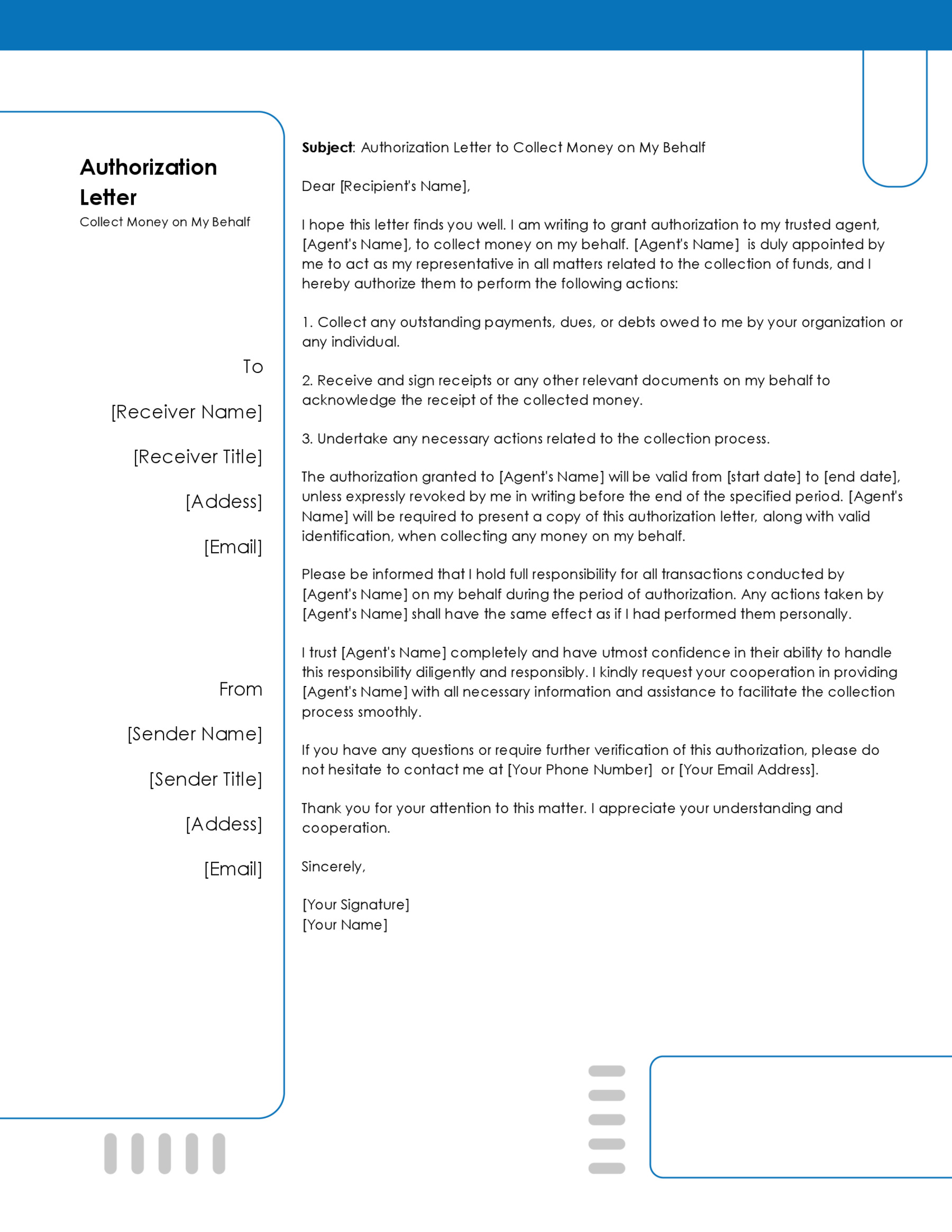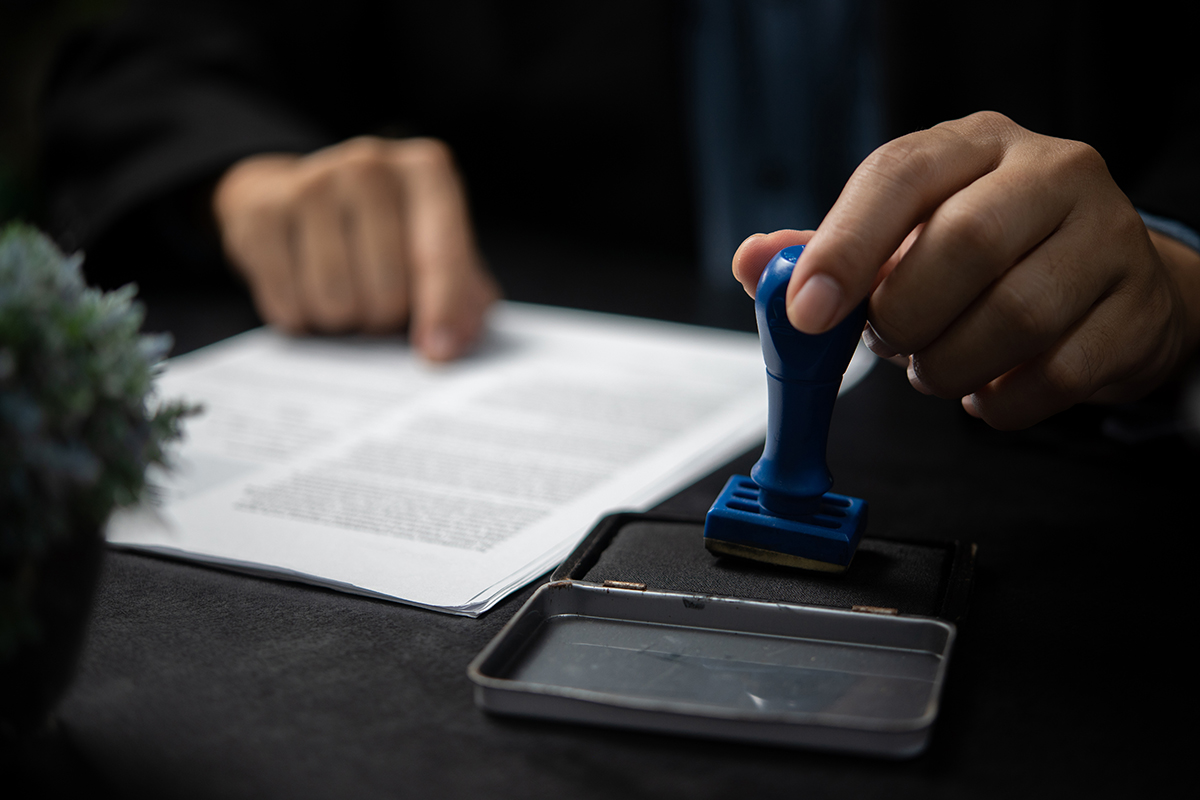Authorization letters are common in personal and business transactions. This letter bestows on the named party (an agent or representative) the right to carry out functions and responsibilities specified in the document on behalf of the authorizing party (referred to as the principal in the letter). This letter uses precise legal terminology to communicate what the agent is permitted to do or not.
Ordinarily, the letter grants the agent or representative the powers for a specified period, after which they become null and void unless renewed by both parties. If such a letter is used in a vehicle transfer, it is referred to as an authorization letter to transfer vehicle ownership. It allows the representative to sell a vehicle or transfer its ownership to a new owner if the current owner is absent or unavailable due to unforeseen circumstances, such as death.
Sample Letters and Examples
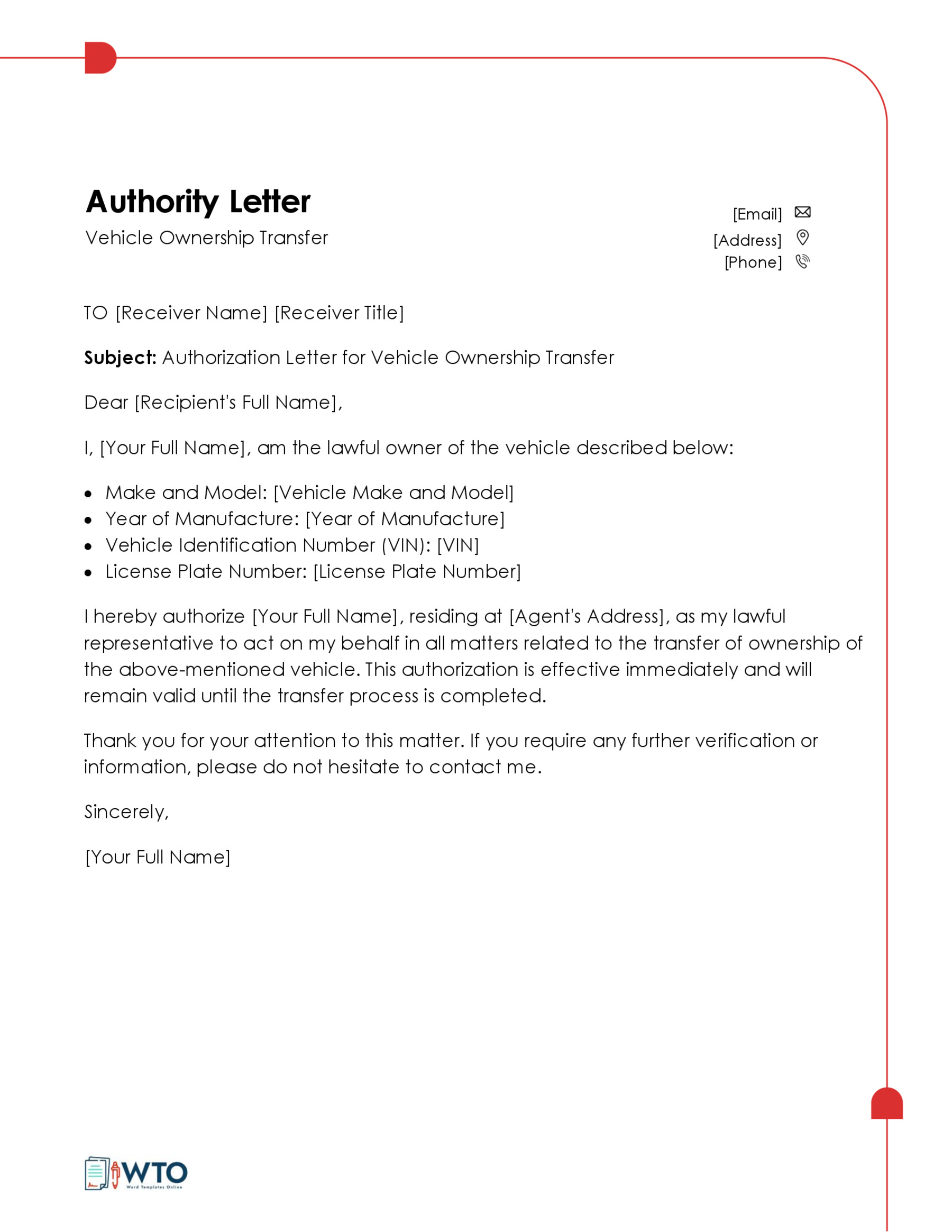
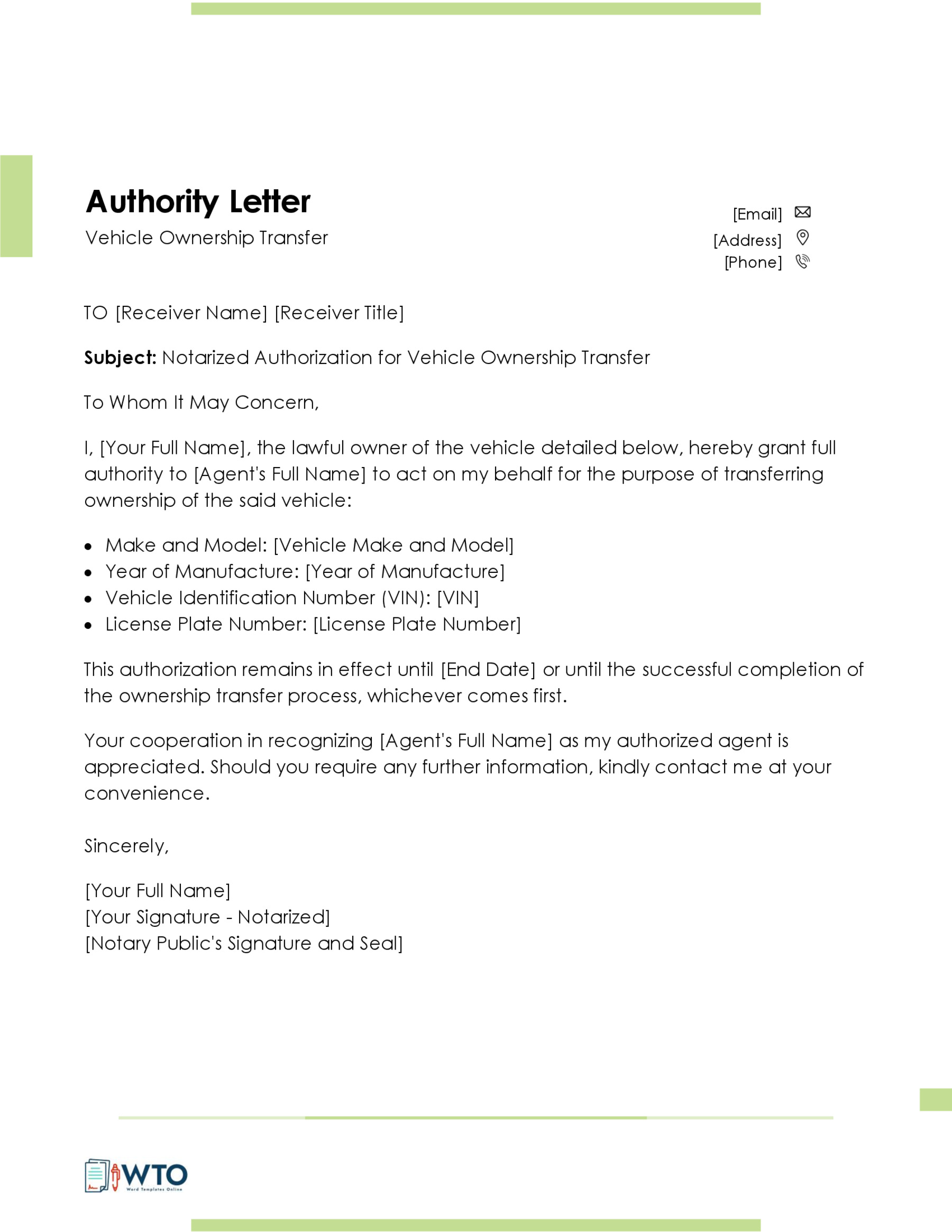
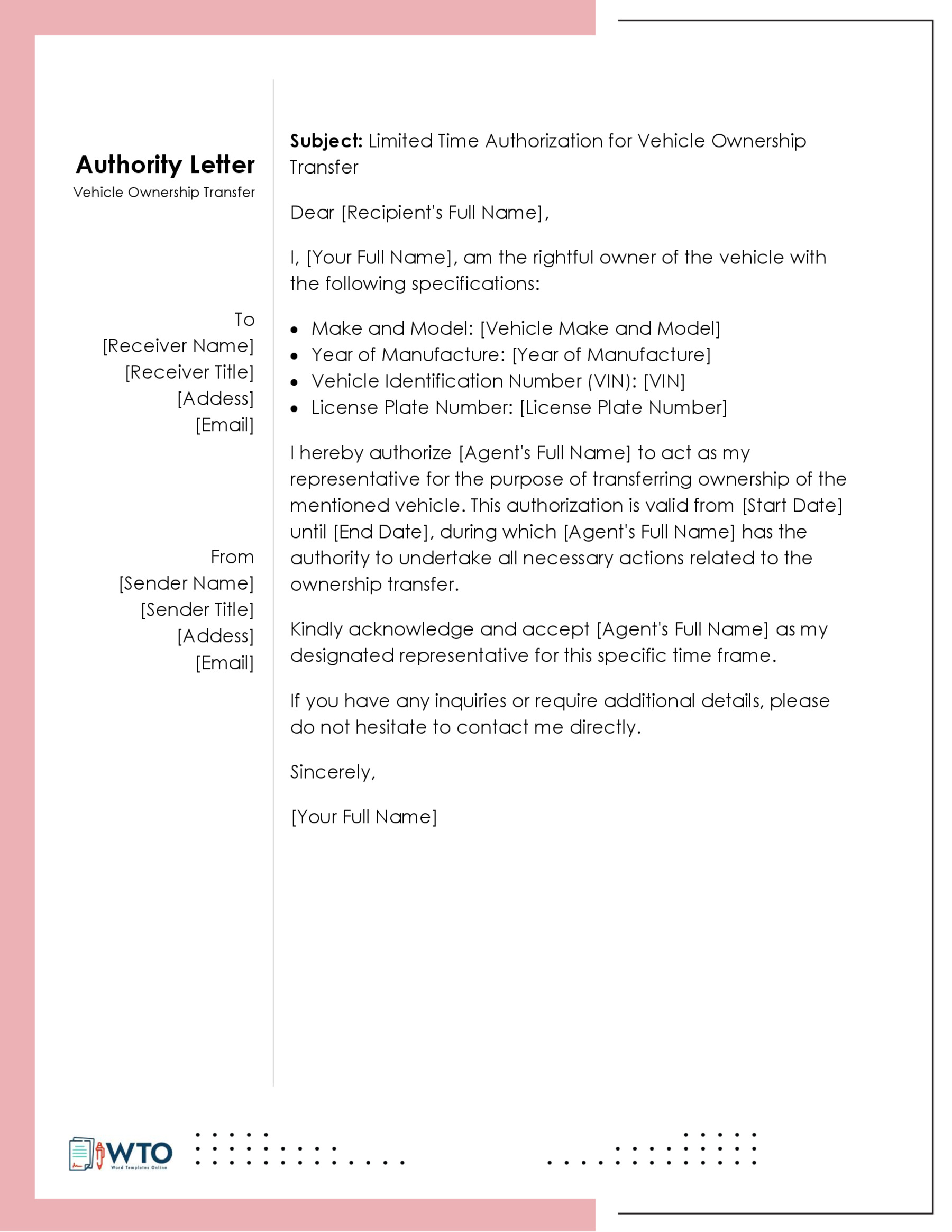
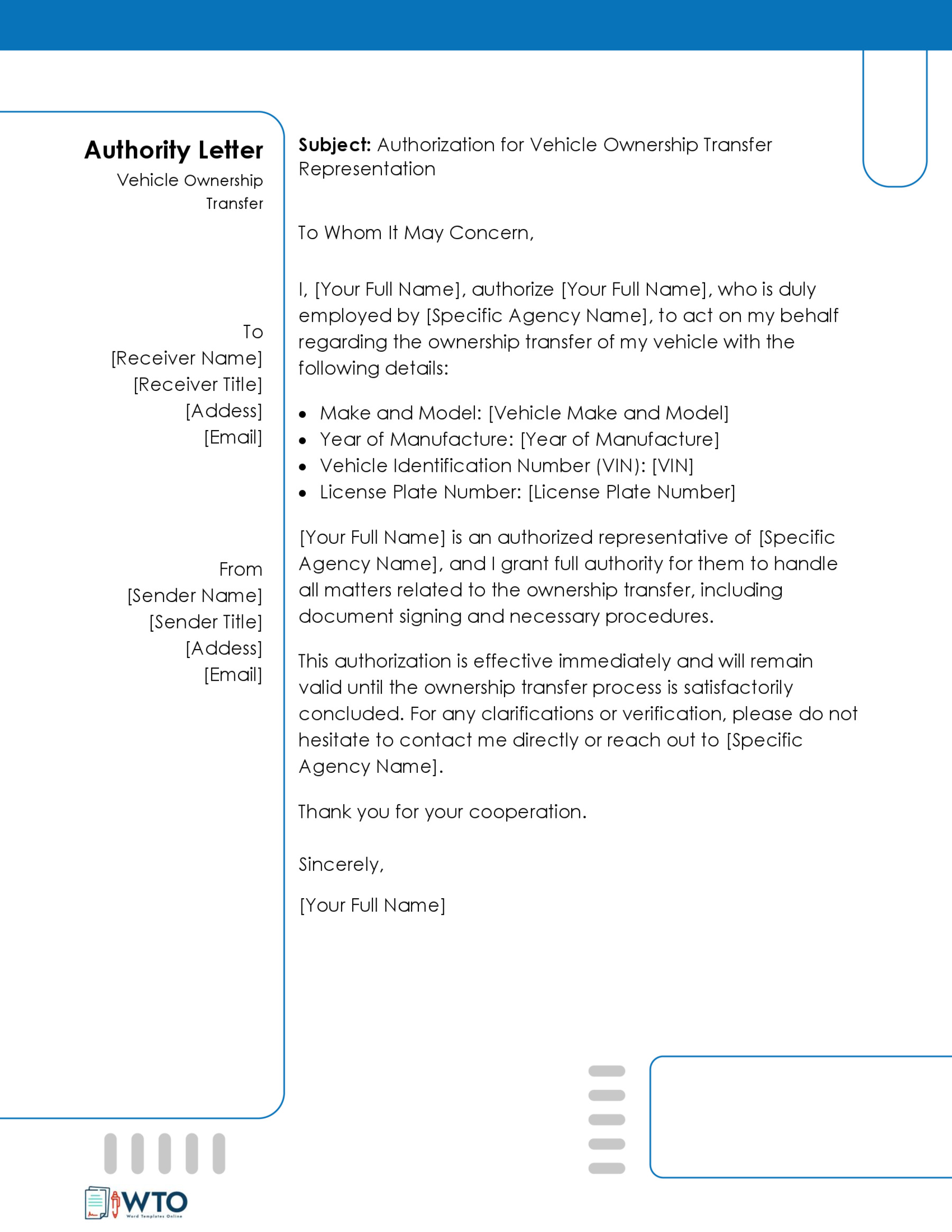
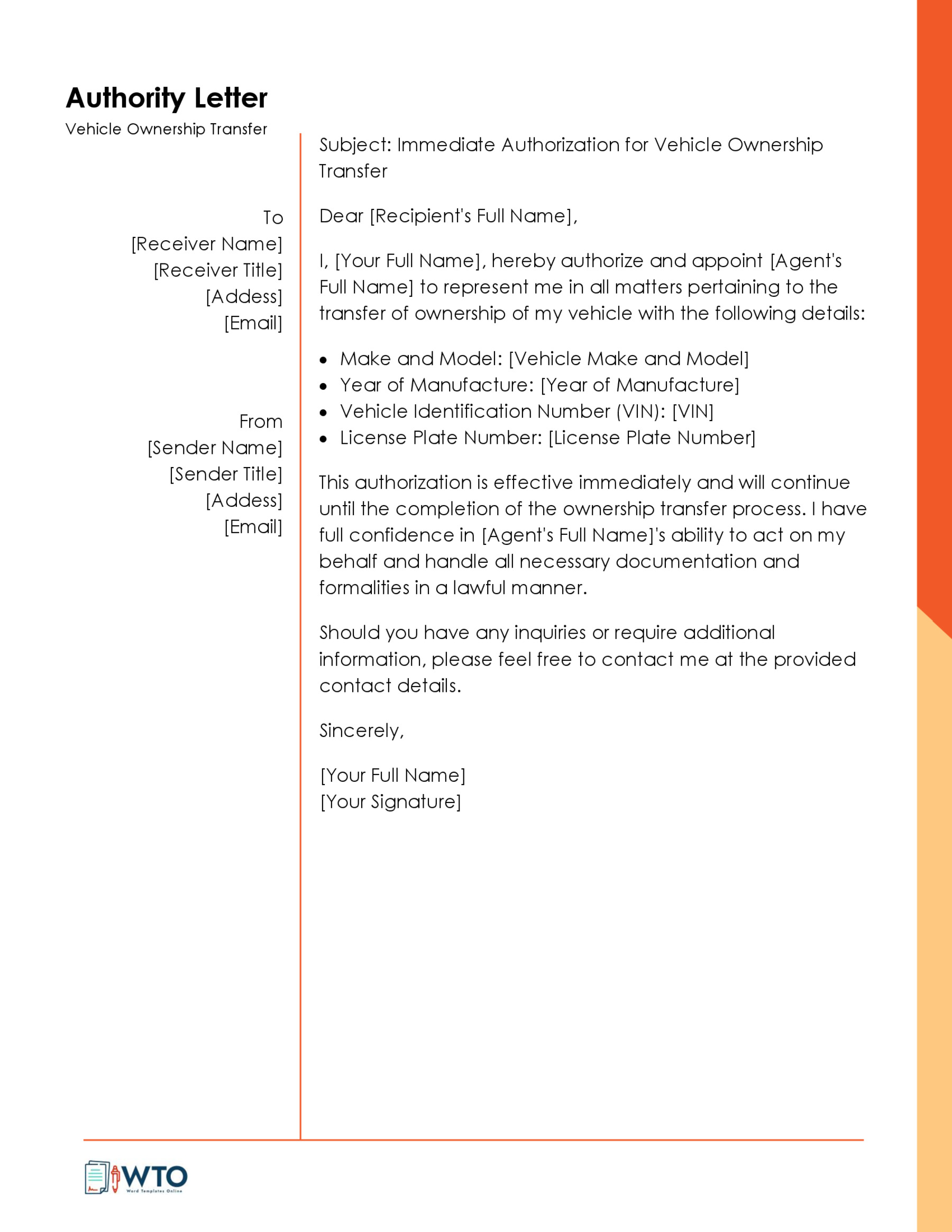
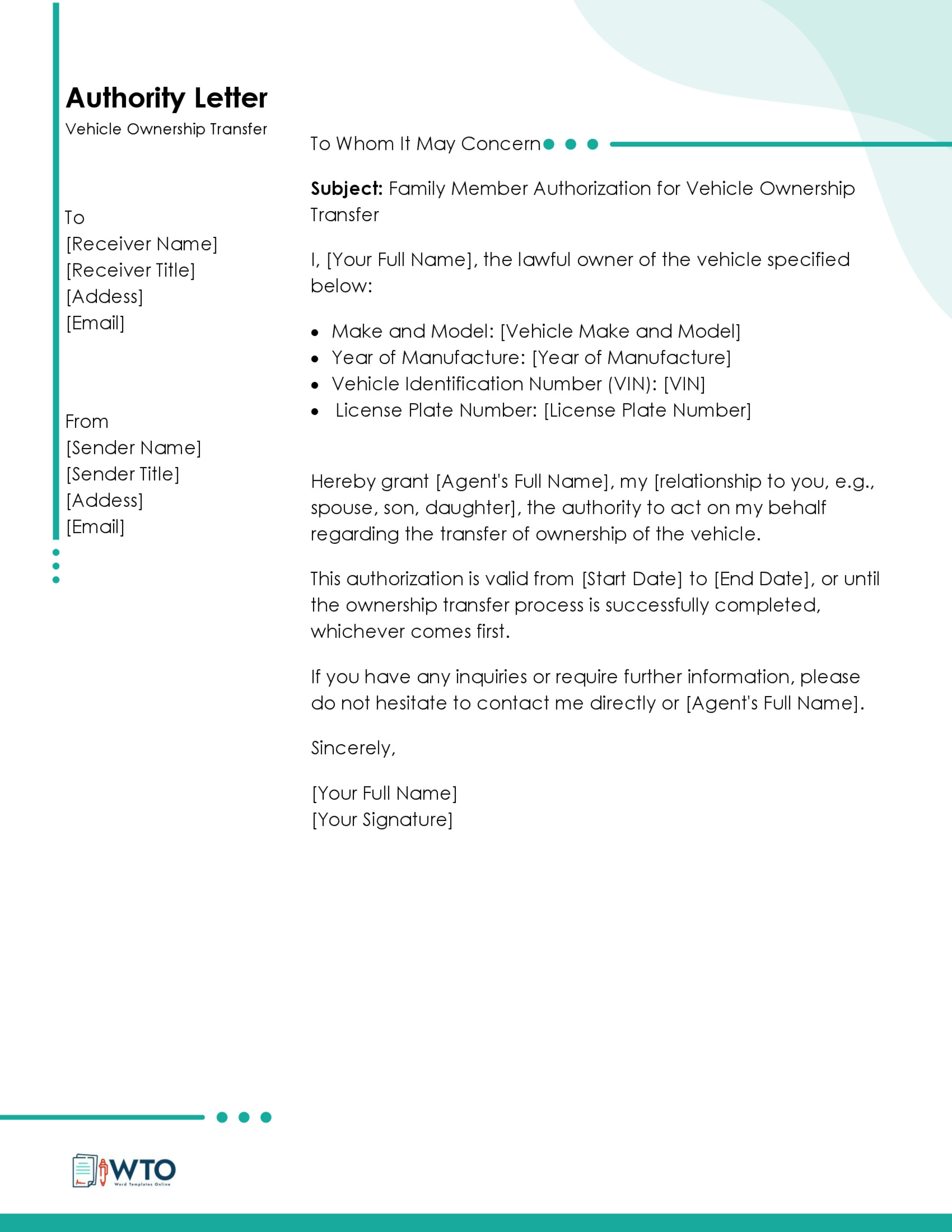
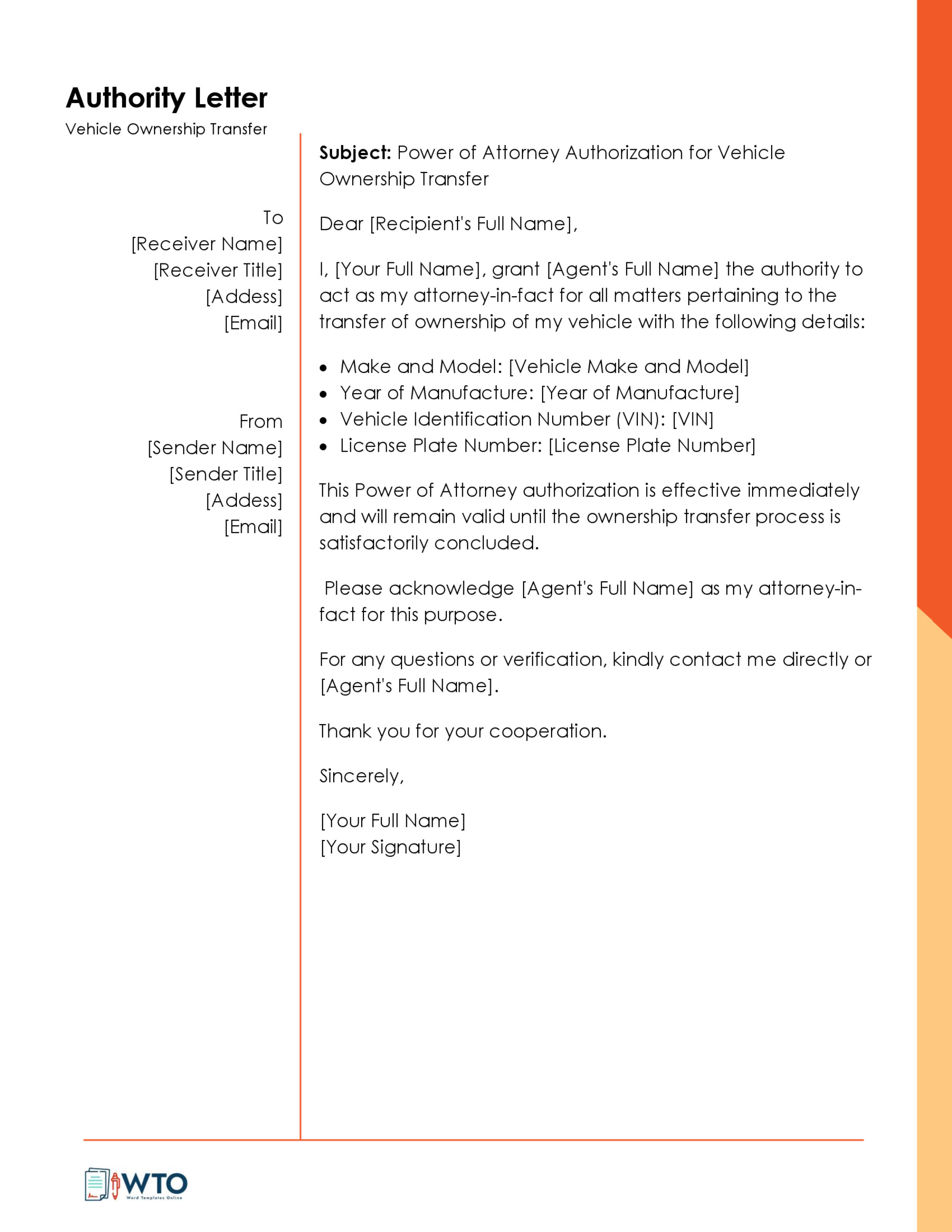
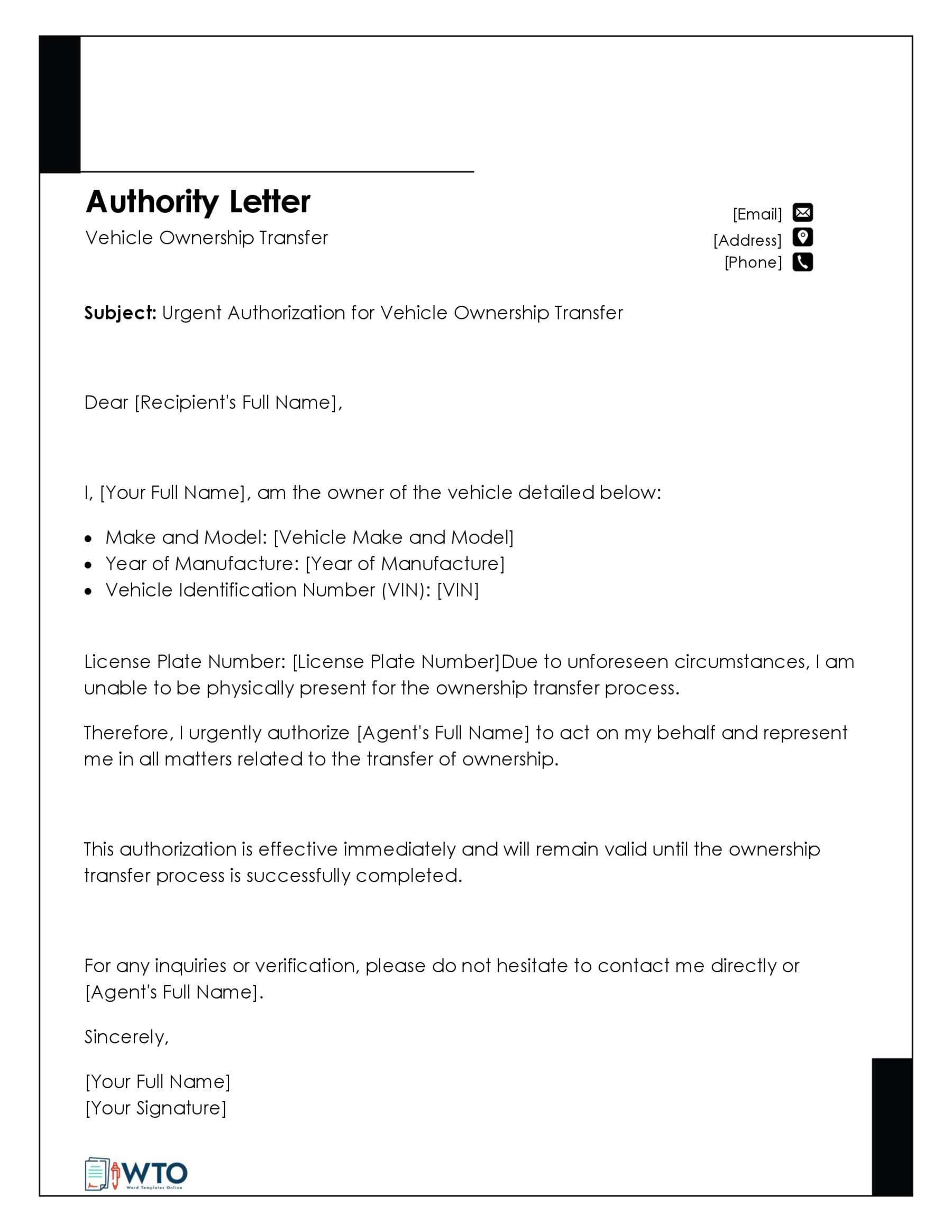
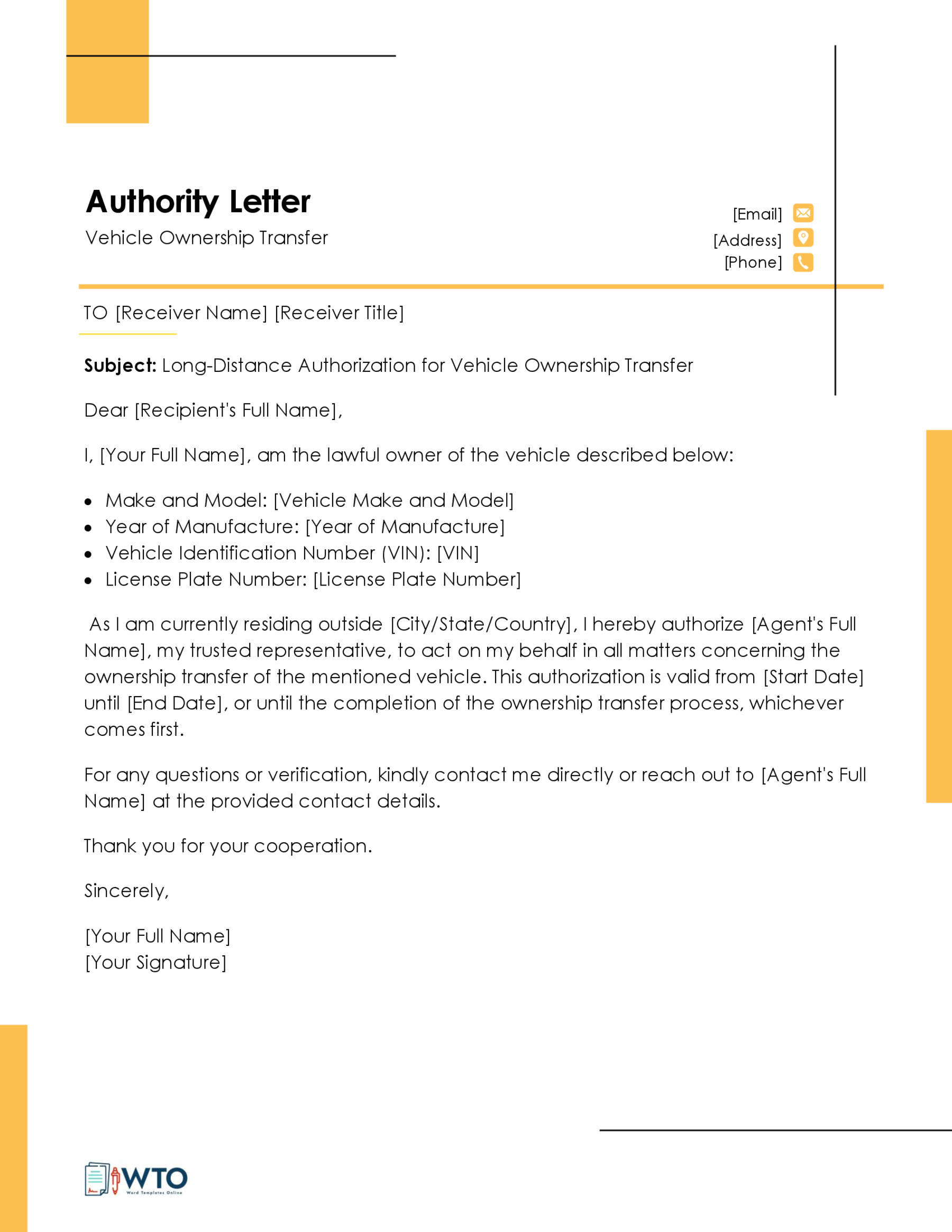
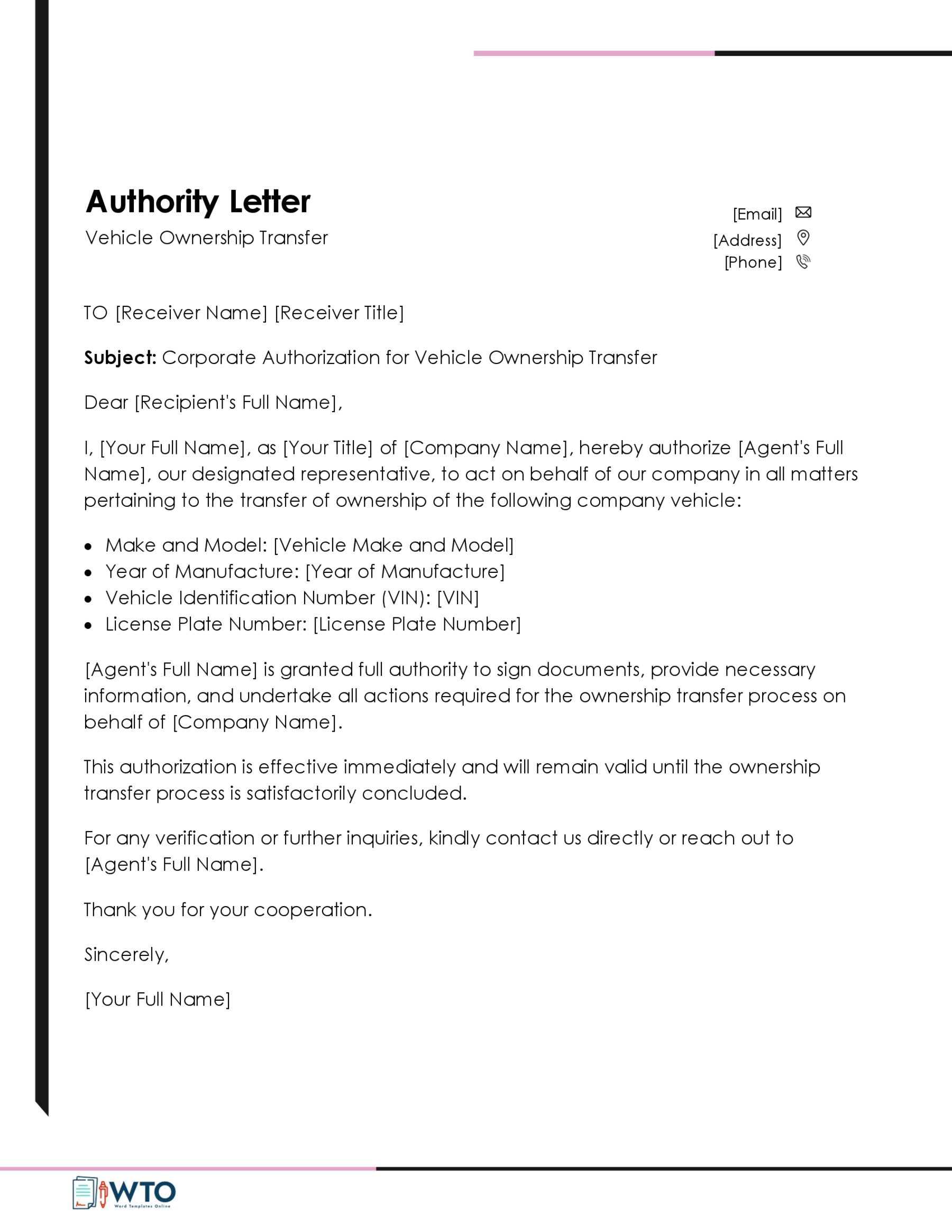
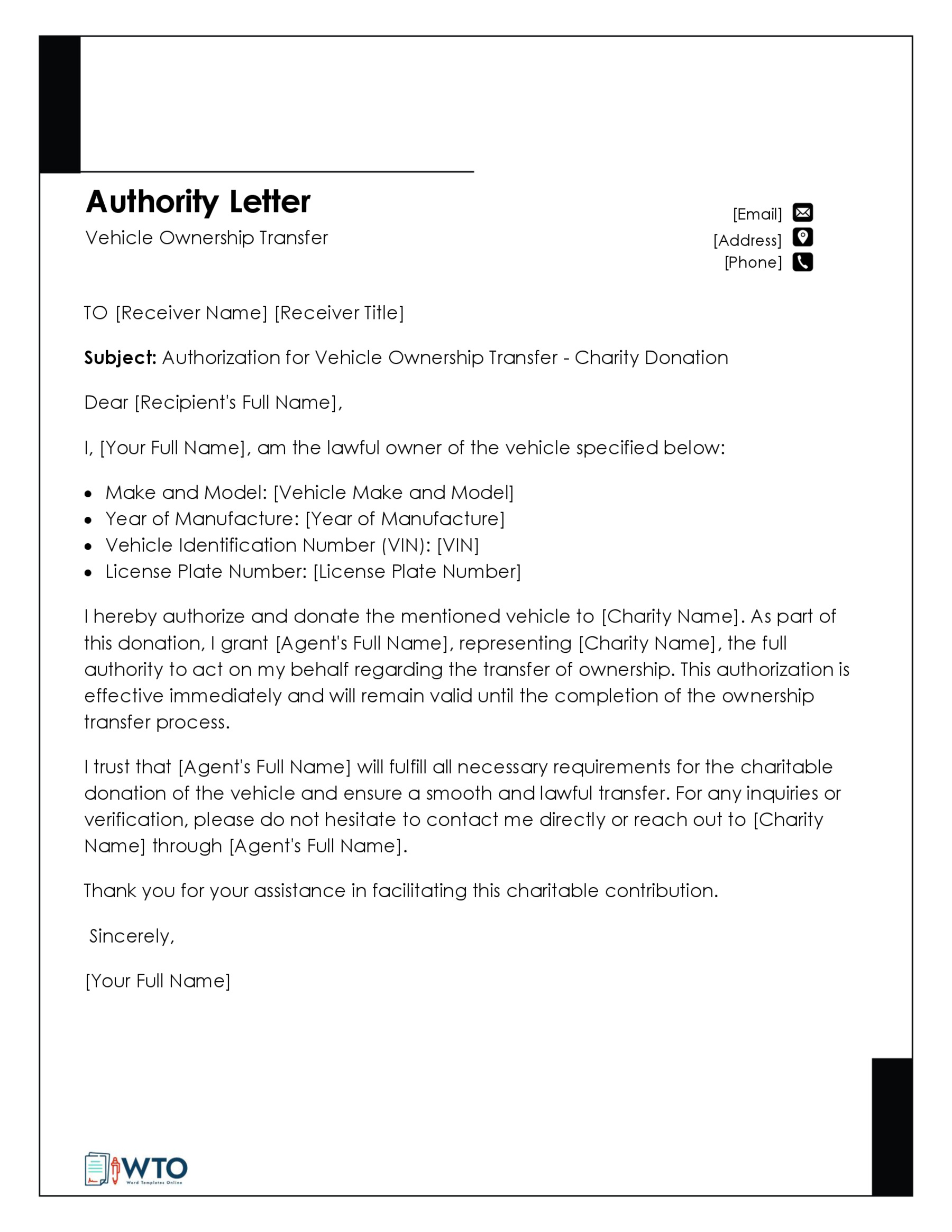
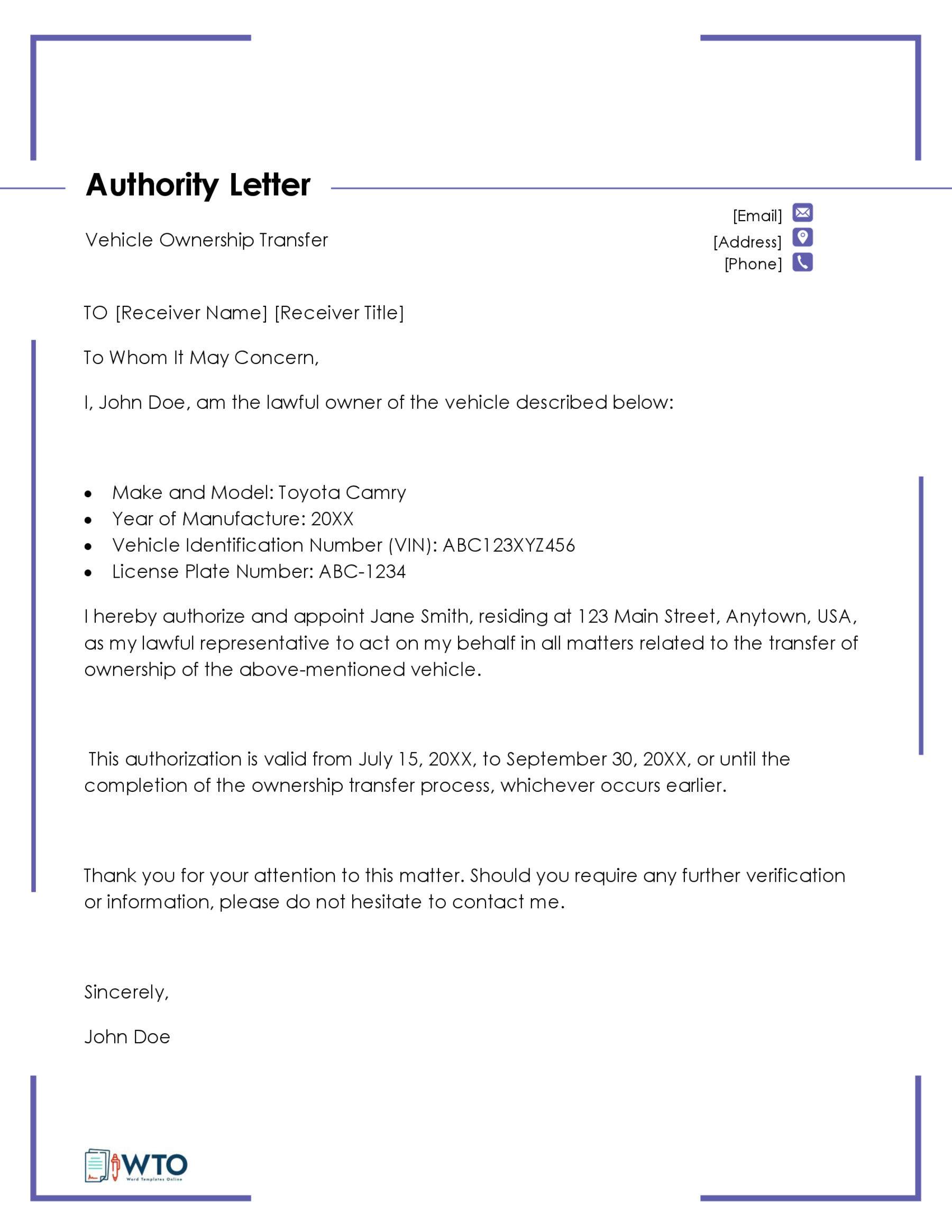
What is an Authorization Letter?
It is a legal document that grants an individual or entity the right to sell (transfer ownership) or perform other functions related to the sale of a vehicle on behalf of the vehicle owner.
It allows a seller to transfer a vehicle’s title or register it under their name. This will usually be after the buyer has paid an agreed-upon price for the vehicle.
Involved parties
A vehicle transaction involving this letter typically involves three parties. They include:
- Seller or the first owner of the vehicle: The first party is the primary owner of the vehicle. The owner is the vehicle’s seller and the principal in the authorization letter. The principal may be the person whose name is on the vehicle’s registration.
- The registering authority: The second party is the person or entity awarded the rights to officiate the vehicle ownership transfer on behalf of the first party (the seller or first owner of the vehicle) and the buyer.
- Buyer or the new owner of the vehicle: The third party is the individual or entity obtaining vehicle ownership from the vehicle’s owner. The vehicle documentation should be transferred to the buyer’s name.
How to Write an Authorization Letter?
It should include all pertinent information to avoid misunderstandings and situations where the designated authority exceeds its authority. Each letter will have its unique stipulations. However, the following essential elements should appear on a typical letter to transfer vehicle ownership:
The first component of the letter is a header. The header is meant to accommodate details about the seller and buyer. Since the letter is in a standard business format, it should be structured as indicated below:
Sender’s details
At the beginning of the header, indicate the seller’s details. This will typically include the full name, physical address, phone number, or other contact details. In addition, some sellers include an email address or fax number.
Date
Since it is a legal document, it should be dated. The authorizing agent should see when the letter was written for record-keeping. The date should be written appropriately to indicate the day, month, and year.
Recipient’s details
After the date, details about the registering authority should be provided. This should include the company’s name or official business name, a physical address, a valid phone number, or any other contact information.
Subject of the letter
It is a formal letter; it is best to indicate the subject of the document. Give the book a short but comprehensive title.
EXAMPLE
Authorization letter for car ownership transfer.
Professional greetings
After the subject line, greet the recipient with a formal greeting. A formal greeting can be written in two ways: one when the recipient’s name is known and another when it is not.
EXAMPLEs
Dear Miles Hugh” or “To Whom It May Concern.
EXAMPLE
Jimmy Saw,
7663 Claw Avenue,
Miami, FL 3746
10 December 2022
Grandy Autos,
Peach Street,
New York, NY 2034
RE: Authorization letter for vehicle ownership
To Whom It May Concern
note
The vehicle’s buyer and the seller must submit their IDs for verification.
Introduction
The next item should be a brief but effective introductory statement that includes the letter’s purpose, declares that the vehicle’s ownership is being transferred, and indicates to whom it is being transferred.
EXAMPLE
I am officially transferring the ownership of my vehicle to Jamie, which I rightfully own. Therefore, I urge you to transfer ownership of the said vehicle to him.
Body
After the introduction, discuss all the specified authorization and car ownership transfer details. The following details can be discussed in this section:
Date of transfer
Indicate the date the ownership transfer is going to take place. This is the effective date of the buyer’s or new owner’s ownership of the vehicle. Make sure to indicate the day, month, and year.
Essential details of the vehicle
Mention details about the vehicle to specify which car will be transferred from the principal to the buyer. This section can cover the following information:
- Vehicle registration number: A vehicle registration number is a unique number assigned to each registered vehicle.
- Model: The vehicle model is necessary to document as it is a distinguishing characteristic of any vehicle.
- Color: The car’s color must be documented, as it is necessary to identify the car to transfer ownership of the vehicle.
- VIN of the vehicle: A vehicle identification number is a number given to each vehicle by the manufacturer, and it is used for differentiating vehicles.
Amount paid
The exact amount of money received from the buyer in exchange for ownership should be stated. The paid amount should be specified in figures, words, and the appropriate currency.
Request to change the ownership of the vehicle
Afterward, an official request to the registering authority to transfer ownership to the new owner (the buyer) should be provided. The request should be clear and direct so that it cannot be misinterpreted for any other request other than the transfer of the vehicle’s ownership.
Reference to the attached documents
Ordinarily, it will be accompanied by supporting documents to officiate the transfer of authority and ownership. The following documents can be attached to this letter:
- Identity cards of the seller and buyer: Copies of the seller’s ID and the buyer’s ID must be given for verification purposes. The registering authority can verify the parties’ identities (buyer and seller) using copies of their ID documents.
- Deed of the sale: A copy of the sale deed should also be submitted. The deed of sale typically outlines all the terms of the sale and information about the transaction.
- LTO, OR, and CR: A CR is a certificate of registration that shows the vehicle was registered within the same jurisdiction. The LTO, OR, and CR are technical documentation of the vehicle, such as chassis number, number of cylinders, motor number, etc.
EXAMPLE
Ms. May has fulfilled her terms of the contract of sale by paying $5300 as a purchase fee for my blue sub-urban Model 302G. We intend to finalize the transaction by Dec. 13. Through this letter, I request that you change the vehicle’s ownership to the new owner of this vehicle.
I have attached copies of the following documents:
• Deed of Sale;
• Certificate of Registration;
• LTO and OR
Conclusion
Afterward, the letter can be concluded. The conclusion should contain an appreciation statement, a complimentary close, the buyer and seller’s signatures, and details. The letter can also be finalized with a notary public acknowledgment or witness statement.
EXAMPLE
Thank you for being so cooperative.
Yours Sincerely,
Seller’s signature
Buyer’s signature
Notary public signature
The letter can be notarized if necessary. However, it is worth considering since the notary public can increase the legal enforceability of the document.
note
Any authorization letter to transfer vehicle ownership should be typed. Handwritten letters should be avoided as they can sometimes be illegible.
Template Authorization Letter
[Your Name]
[Your Address]
[City, State, Zip Code]
[Your Email Address]
[Your Phone Number]
[Date]
[Recipient’s Name]
[Recipient’s Address]
[City, State, Zip Code]
Dear [Recipient’s Name],
I, [Your Name], hereby authorize [Authorized Person’s Name] to act on my behalf in the transfer of ownership of my vehicle with the following details:
- Make: [Make of the Vehicle]
- Model: [Model of the Vehicle]
- Year: [Year of Manufacture]
- Vehicle Identification Number (VIN): [VIN Number]
- License Plate Number: [License Plate Number]
- Current Mileage: [Current Mileage of the Vehicle]
I am unable to be present for the transfer process due to [reason for absence]. Therefore, I hereby grant [Authorized Person’s Name] full authority to sign all necessary documents, provide all required information, and complete any necessary procedures related to the transfer of ownership of the above-mentioned vehicle.
I declare that I have full legal ownership of the vehicle and that there are no outstanding liens, claims, or encumbrances on the vehicle’s title.
Furthermore, I authorize [Authorized Person’s Name] to collect any documents or certificates related to the transfer of ownership and to take any other actions deemed necessary to facilitate the transfer process.
I have attached copies of my identification documents, including [list of identification documents attached], for verification purposes.
Please do not hesitate to contact me at [Your Phone Number] or [Your Email Address] if you require any further clarification or information regarding this authorization.
Thank you for your prompt attention to this matter.
Sincerely,
[Your Name]
[Your Signature]
Enclosures:
- Copy of identification documents
- Any other relevant documents
Sample Authorization Letter
Dear Jane Smith,
I, John Doe, hereby authorize Sarah Johnson to act on my behalf in the transfer of ownership of my vehicle with the following details:
- Make: Toyota
- Model: Camry
- Year: 2018
- Vehicle Identification Number (VIN): ABC123DEF456GHI789
- License Plate Number: XYZ-456
- Current Mileage: 45,000 miles
I am unable to be present for the transfer process due to overseas travel commitments. Therefore, I hereby grant Sarah Johnson full authority to sign all necessary documents, provide all required information, and complete any necessary procedures related to the transfer of ownership of the above-mentioned vehicle.
I declare that I have full legal ownership of the vehicle and that there are no outstanding liens, claims, or encumbrances on the vehicle’s title.
Furthermore, I authorize Sarah Johnson to collect any documents or certificates related to the transfer of ownership and to take any other actions deemed necessary to facilitate the transfer process.
I have attached copies of my identification documents, including a copy of my driver’s license and passport, for verification purposes.
Please do not hesitate to contact me at (555) 123-4567 or johndoe@email.com if you require any further clarification or information regarding this authorization.
Thank you for your prompt attention to this matter.
Sincerely,
John Doe
[Signature]
Enclosures:
- Copy of driver’s license
- Copy of passport
Key Takeaways
The provided letter serves as a formal authorization for an individual to act on behalf of another in the transfer of ownership of a vehicle. Let’s break down why this letter is effective:
Clear Identification: The letter starts with a clear identification of both parties involved, establishing who is authorizing and who is being authorized, ensuring clarity from the beginning.
Specific Details: The letter provides specific details about the vehicle being transferred, including make, model, year, VIN, license plate number, and current mileage. These details are crucial for accurately identifying the vehicle and facilitating the transfer process smoothly.
Reason for Authorization: The letter explains the reason for authorizing someone else, citing circumstances that prevent the owner from being present for the transfer process. This explanation adds context to the authorization and justifies the need for someone else to act on the owner’s behalf.
Scope of Authorization: The letter clearly outlines the scope of the authorized individual’s authority, stating that they are authorized to sign necessary documents, provide required information, and complete any procedures related to the transfer of ownership. This ensures that the authorized individual has the necessary authority to carry out the transfer process efficiently.
Declaration of Ownership: The owner declares full legal ownership of the vehicle and confirms that there are no outstanding liens, claims, or encumbrances on the vehicle’s title. This declaration reassures the recipient that the transfer is being conducted with full ownership rights.
Authorization for Additional Actions: In addition to the transfer process, the authorized individual is also authorized to collect any related documents or certificates and to take any other necessary actions to facilitate the transfer. This broad authorization ensures flexibility to handle any unforeseen circumstances.
Enclosures: The letter concludes with a list of enclosures, including copies of the owner’s identification documents for verification purposes. This demonstrates transparency and provides the recipient with the necessary documentation to authenticate the authorization.
Overall, this letter effectively communicates the owner’s authorization for someone else to handle the transfer of ownership of the vehicle in their absence. It is clear, concise, and provides all the necessary information for the recipient to proceed with the transfer process smoothly.
Conclusion
Vehicle or automobile owners can transfer their vehicle ownership to a buyer without getting involved in several complicated steps. The seller or previous owner of the vehicle needs to write an authorization letter to transfer ownership to the buyer or new owner of the vehicle. The letter becomes a legal admission that the seller relinquishes ownership to the named buyer. It is submitted when the buyer registers the vehicle in their name. Therefore, these letters to transfer vehicle ownership make automobile sales convenient for two people in different regions, like county-to-county or state-to-state.

